|
|
|
Sort Order |
|
|
|
Items / Page
|
|
|
|
|
|
|
| Srl | Item |
| 1 |
ID:
082551


|
|
|
|
|
| Publication |
2008.
|
| Summary/Abstract |
Focusing on the western Himalayan provinces of Kashmir and Himachal Pradesh, this article argues that the Indian hagiographic texts of the Puranas should be understood as a nuanced literature that sought to effect a paradigm shift in liturgy and praxis, fusing polity and religion, largely in contravention to the earlier Vedic-Upanishadic texts and their commentaries, but also building on them. Emphasis on local Sanskrit literature, specifically the Nilamata Purana, which uses popular iconographies of river goddesses, served many centuries ago to reconstruct the geography of the area within the wider context of the subcontinental sacred geography.
Keeping within the Puranic tradition, the article focuses on the rituals and ceremonials associated with rivers, while also charting the process by which regional pilgrim centres were formed on their banks, devising a sacred space parallel to the subcontinental cosmos. This reinforces the logic of the sacred river, the worshipped deity, as a process by which brahmanic dominance was asserted in the peripheral areas of early India, or ideologically and politically contested regions such as Kashmir. In the sacrality of the river Vitasta, Brahmanism as an ideology reasserts itself by restating the tradition in relation to its sacral past, creating a new sacred space and devising a sacred icon to reclaim this particular geography for the devout Brahmanas
|
|
|
|
|
|
|
|
|
|
|
|
|
|
|
|
| 2 |
ID:
096044


|
|
|
|
|
| Publication |
2010.
|
| Summary/Abstract |
This article is an attempt to understand 'locality', where the issues of subversion, subordination and marginalization as well as the problematic notions of liminality and empowerment are more vibrant and real. We shall demonstrate that while the low castes and untouchables were engaged in economic conflict, at various levels, with the high-caste landowners, which resulted in occasional uprisings too, the popular belief system was used by the marginalized as an instrument of assertion of their power against social coercion. It is argued that the social and ritual protest aimed at diluting or subverting the local caste hierarchy in a stratified society is an efficacious threat to the power of the high castes; that the hope of social revision becomes an alternative to economic subordination. More important, the symbols of empowerment are not the ones controlled by the high castes, but those which are located in the specialized rituals of the marginalized dalits. This article is about these symbols, which are liminal in nature, and how they empower, if only for a brief while, the economically exploited and socially marginalized dalit practitioners.
|
|
|
|
|
|
|
|
|
|
|
|
|
|
|
|
|
|
|
|
|